Germany’s mixed success with Zeppelins during the First World War convinced the British and the Americans to take a closer look at these flying behemoths. Although airships turned out to be poor bombers because of their lack of maneuverability, the Navy was interested in exploring their other capabilities.
The British wanted to connect their great empire with airship routes. For this purpose they constructed two large helium-filled airships. One made a successful trip to Canada and back, but when the other crashed on its way to Karachi, killing forty eight people on board, the remaining one was grounded and the British lost interest in rigid airships.
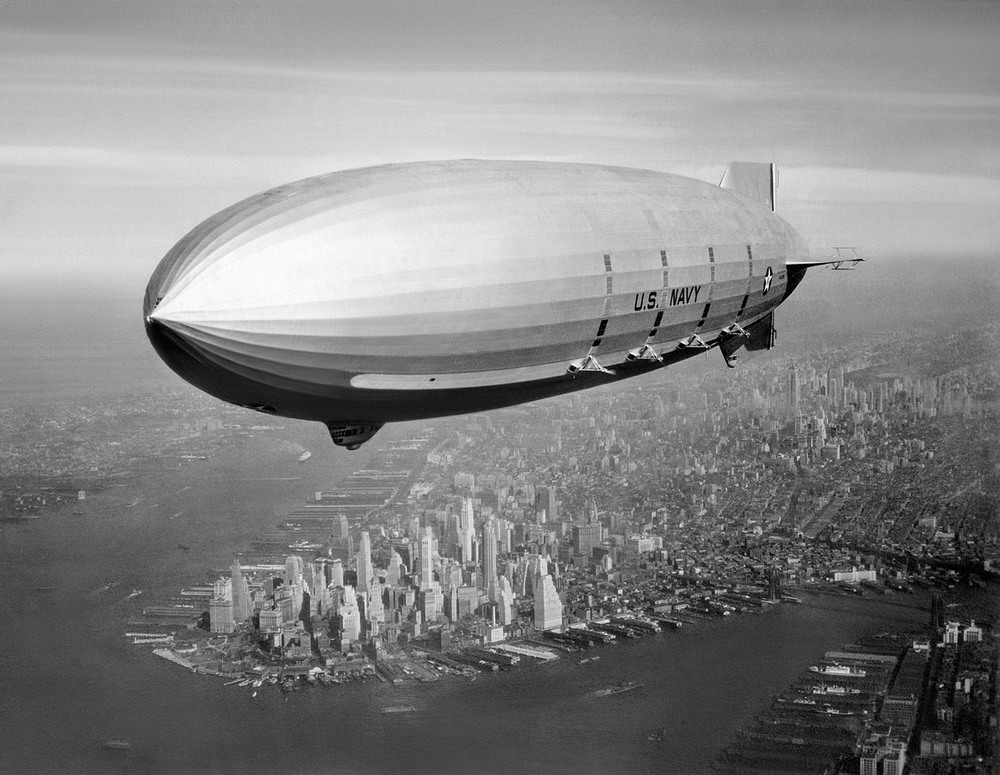
The USS Macon flying over New York Harbor, circa summer 1933.
The US Navy was not interested in ferrying passengers. They wanted to see if the airship could carry fighter planes instead. The Navy wanted to build a flying aircraft carrier, like a mothership, from where smaller fighter jets could launch, engage with the enemy and return back to the mothership for refueling etc. It sounds like alien technology, except, it had been already tried before.
The British came up with the idea first during the Great War itself. Because airships were essentially large floating balloons, they were vulnerable to enemy attacks. The British sought to address this weakness by suspending a parasitic fighter under the belly of the airship. When required this aircraft could detach from its harness while still airborne and defend the airship from enemy planes. Although initial tests were successful, the airships were found to be too bulky and the program was cancelled.
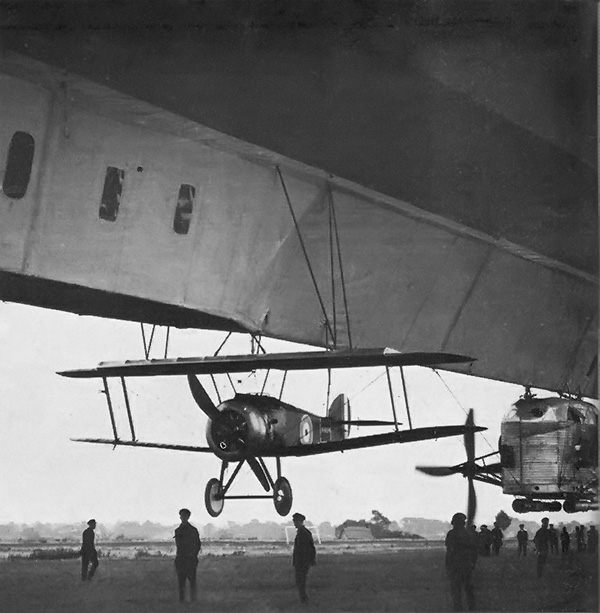
A Sopwith 2F.1 Camel secured under the British HM Airship 23r.
The Germans also experimented with the idea, suspending an Albatros D.III fighter aeroplane below a Zeppelin and releasing it at altitude.
These early systems were not designed to recover an aircraft once it was released. After engaging with the enemy, the fighter plane had to fly back to base leaving the airship undefended for the rest of its trip.
In 1929, the US Navy designed a trapeze system that could launch and recover an aircraft mid-air. The aircraft was fitted with a skyhook on the top of its wings, by which the pilot could hang the aircraft on the underbelly of the airship. The trapeze system was first tried on the USS Los Angeles. Once the Navy was satisfied the system worked, they proceeded to build two large airships, the USS Akron and the USS Macon, which were to act as flying aircraft carriers.
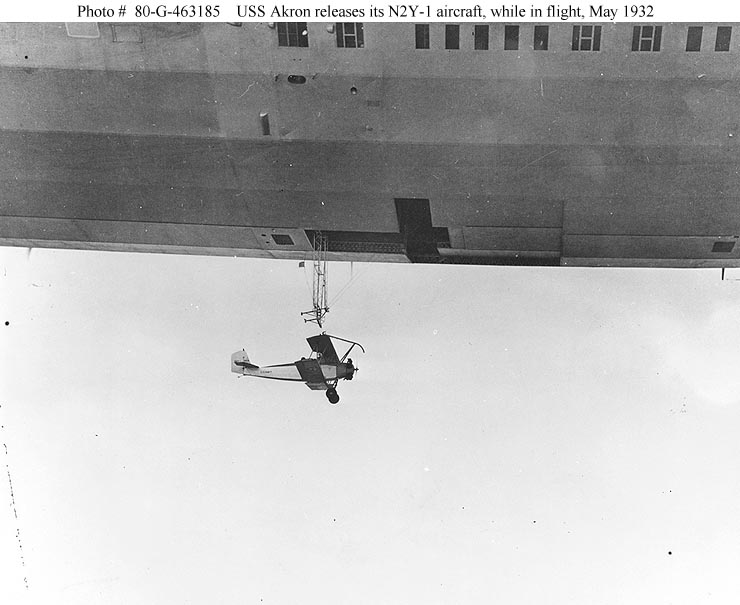
The USS Akron was launched in 1931, and the USS Macon in 1933. Both were humongous ships, 785 feet in length and a hull diameter of 133 feet. The vessels were powered by eight Maybach twelve-cylinder engines developing 6,700 horsepower of combined power, capable of achieving a cruising speed of 100 kmph. The airships were lightly armed, with just eight .30 caliber machine guns.
The heart of the ship was the airplane hangar and trapeze system. Each airship carried up to five Curtiss F9C Sparrowhawk fighters, lightweight biplanes with a crew of one and armed with two .30 caliber Browning machine guns.
The trapeze was lowered through the T-shaped door in the bottom of the ship and into the slipstream, from which hung an airplane by a skyhook above its top wing. The pilot tripped the hook and the airplane fell away from the ship. On his return, the pilot positioned himself beneath the trapeze and climbed up until he could fly his skyhook onto the crossbar, at which point it automatically latched shut. The trapeze and airplane were then raised into the hangar.
The system had one glaring defect—there was only one trapeze, which limited the rate at which airplanes could be launched and recovered. Furthermore, if the trapeze got damaged it would leave any airborne scouts stranded with nowhere to land. As a solution, a second fixed trapeze was attached to the bottom of the ship.

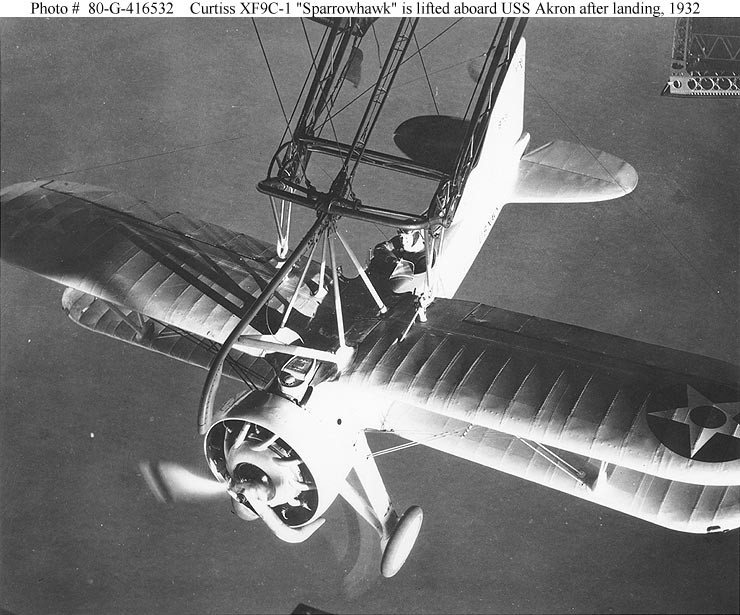
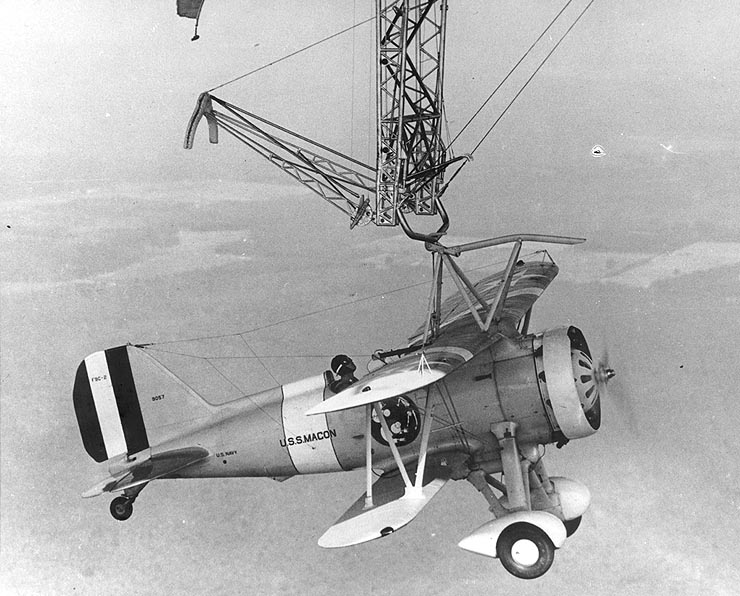
A Curtiss F9C Sparrowhawk attached by a "skyhook" to USS Macon.
On April 3, 1933, USS Akron was on a mission to calibrate its radio equipment off the coast of New Jersey when it ran into a pocket of exceptionally strong updrafts and downdrafts. The crew lost control of the craft and it plunged into the ocean. The accident left 73 dead, and only three survivors.
On February 12, USS Macon was over the Pacific ocean when a storm caused the upper fin to fail. Macon had suffered damage to the fin months earlier, but the Navy had failed to repair the damage. The ship’s gas cells got punctured and as the helium leaked out, the ship descended into the ocean. Because Macon’s crash was more controlled and there were life jackets and life preservers aboard the airship, the loss of lives was limited to only two.
The loss of both airships effectively ended the flying aircraft carrier program. Together with the advent of long-range fighters equipped with air-to-air missiles and aerial refueling, the entire concept of flying aircraft carrier was discarded in favor of safer solutions.



Comments
Post a Comment